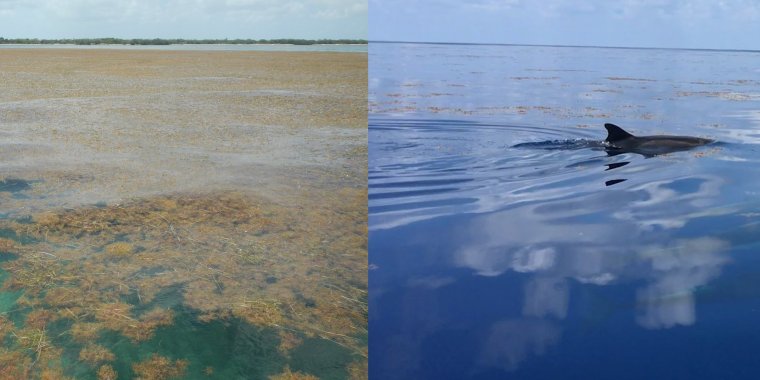| News / Science News |
Satellites Find Biggest Seaweed Bloom in the World
An unprecedented belt of brown algae stretches from West Africa to the Gulf of Mexico—and it’s likely here to stay. Scientists at the University of South Florida in St. Petersburg's College of Marine Science used NASA satellite observations to discover and document the largest bloom of macroalgae in the world, dubbed the Great Atlantic Sargassum Belt.

(Left) An unhealthy amount of Sargassum off Big Pine Key in the lower Florida Keys. Photo: Brian Lapointe, Ph.D., Florida Atlantic University’s Harbor Branch Oceanographic Institute. (Right) In patchy doses in the open ocean, Sargassum contributes to ocean health by providing habitat for marine life. Photo: Mengqiu Wang
Based on computer simulations, they confirmed that this belt of the brown macroalgae Sargassum forms its shape in response to ocean currents. It can grow so large that it blankets the surface of the tropical Atlantic Ocean from the west coast of Africa to the Gulf of Mexico. In 2018, more than 20 million tons of it floated in surface waters and became a problem to shorelines lining the tropical Atlantic, Caribbean Sea, Gulf of Mexico, and east coast of Florida.
Chuanmin Hu of the USF College of Marine Science, who led the study, has studied Sargassum using satellites since 2006. Hu spearheaded the work with first author Dr. Mengqiu Wang, a postdoctoral scholar in his Optical Oceanography Lab at USF. The data they analyzed from NASA’s Moderate Resolution Imaging Spectroradiometer (MODIS) between 2000-2018 indicates a possible regime shift in Sargassum blooms since 2011.
In the satellite imagery, major blooms occurred in every year between 2011 and 2018 except 2013. This information, coupled with field measurements, suggests that no bloom occurred in 2013 because the seed populations of Sargassum measured during winter of 2012 were unusually low.
Before 2011, most of the free floating Sargassum in the ocean was primarily found in patches around the Gulf of Mexico and Sargasso Sea. The Sargasso Sea is located on the western edge of the central Atlantic Ocean and named after its popular algal resident.
In patchy doses in the open ocean, Sargassum contributes to ocean health by providing habitat for turtles, crabs, fish, and birds and, like other plants, producing oxygen via photosynthesis. But too much of this seaweed can crowd out marine species, especially near the coast.
In 2011, Sargassum populations started to explode in places it hadn’t been before, like the central Atlantic Ocean, and then it arrived in gargantuan gobs that suffocated shorelines and introduced a new nuisance for local environments and economies.
The ocean’s chemistry must have changed in order for the blooms to get so out of hand. Sargassum reproduces from fragments of the parent plant, and it probably has several initiation zones around the Atlantic Ocean. It grows faster when nutrient conditions are favorable, and when its internal clock ticks in favor of reproduction.
The team identified key factors that are critical to bloom formation: a large seed population in the winter left over from a previous bloom, nutrient input from West Africa upwelling in winter, and nutrient input in the spring or summer from the Amazon River.
Such discharged nutrients may have increased in recent years due to increased deforestation and fertilizer use, though Hu noted that the evidence for nutrient enrichment is preliminary and based on limited available data, and the team needs more research to confirm this hypothesis. In addition, Sargassum only grows well when salinity is normal and surface temperatures are normal or cooler.
Earth’s ocean biogeochemistry is changing in response to natural and human forcings. The Great Atlantic Sargassum Belt suggests that we may be witnessing ecosystem shifts in our ocean that could have important implications for marine organisms and ecosystem services, which humans depend on. (NASA)
YOU MAY ALSO LIKE





